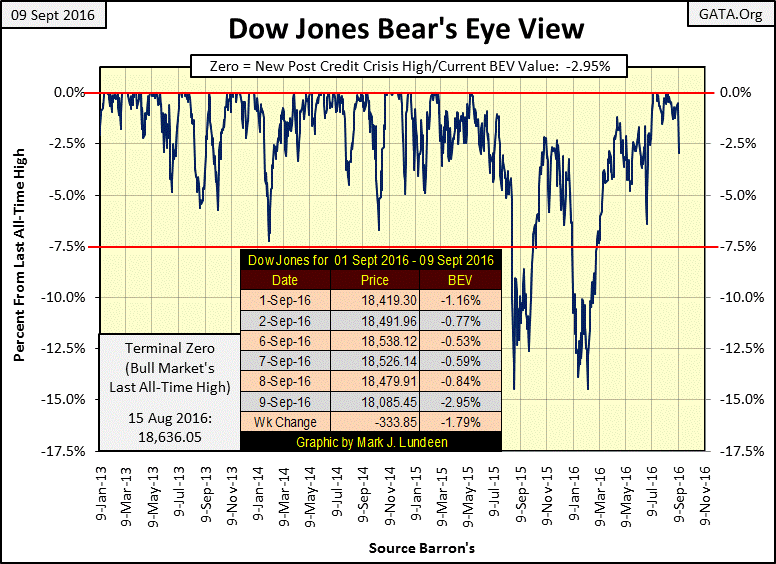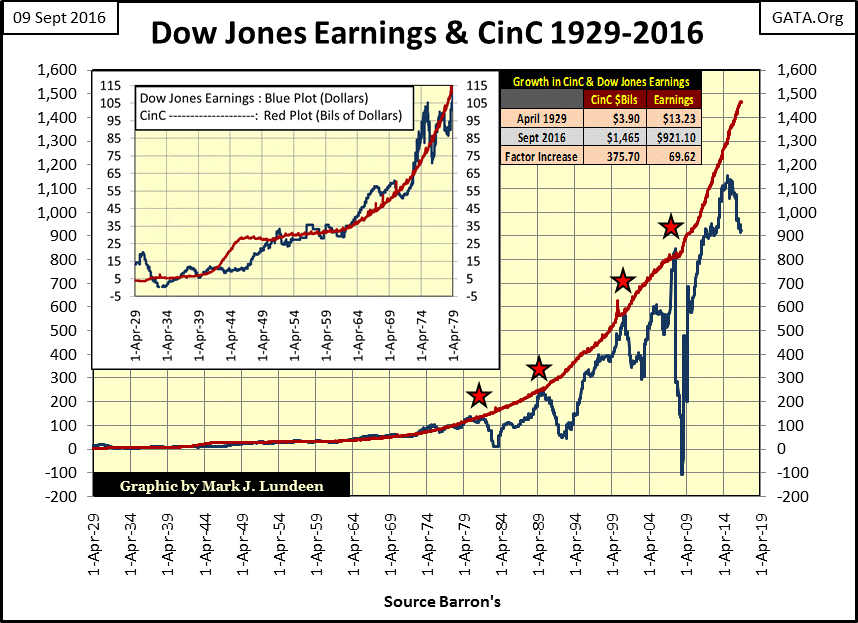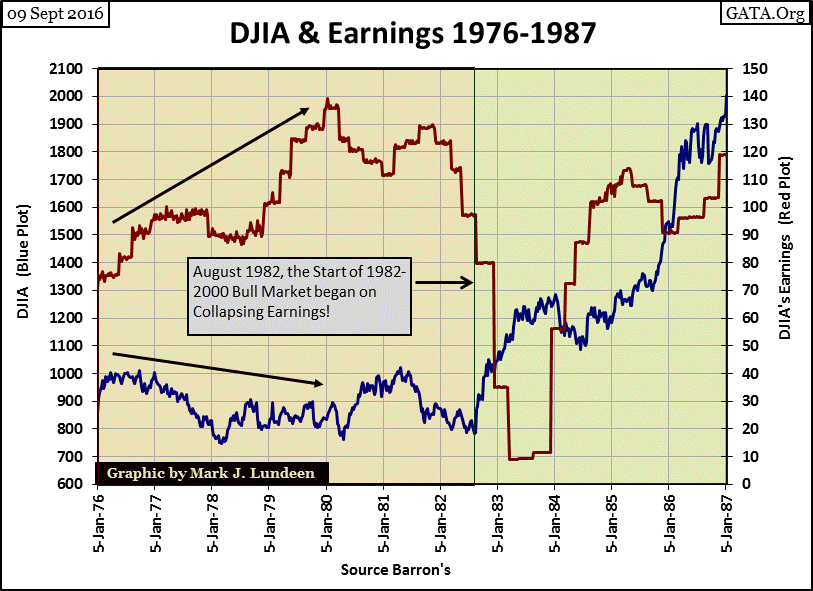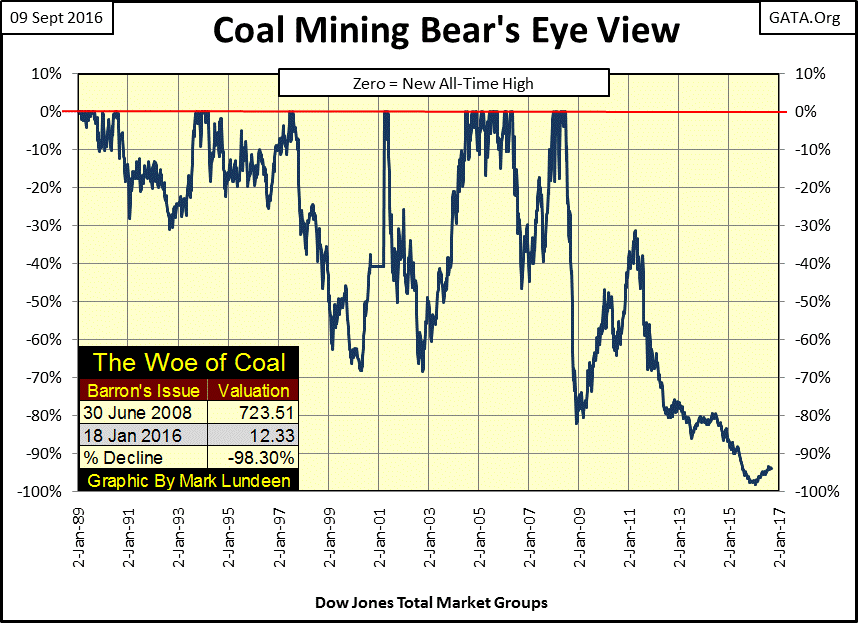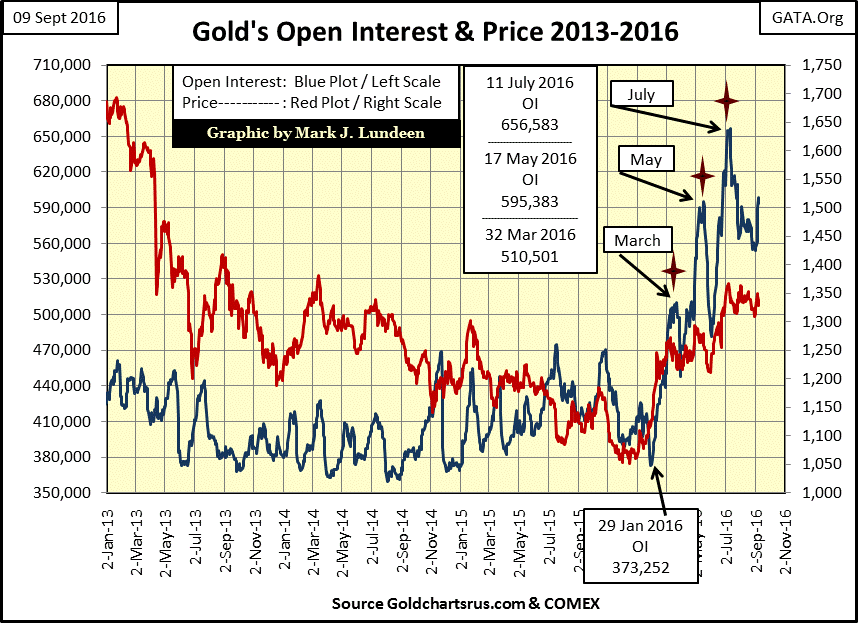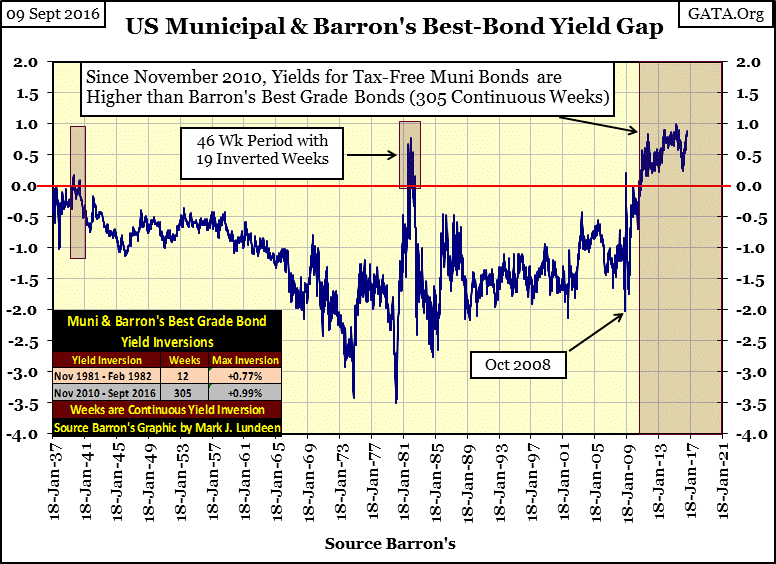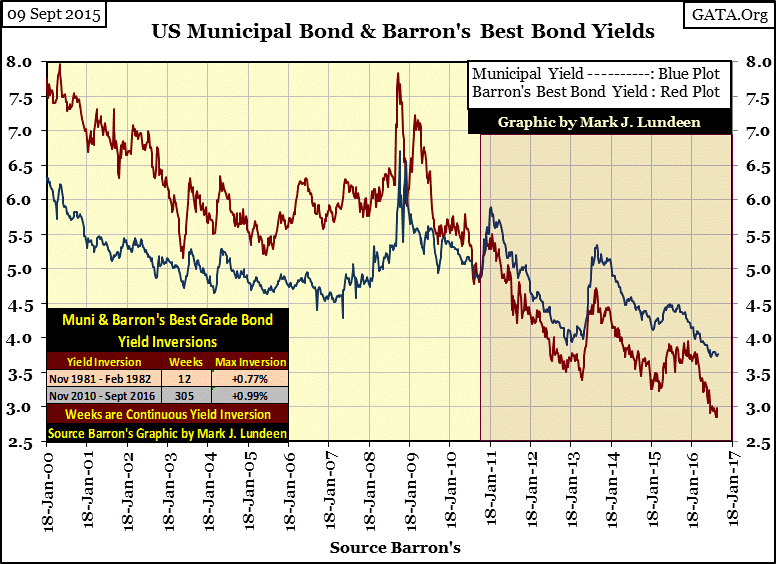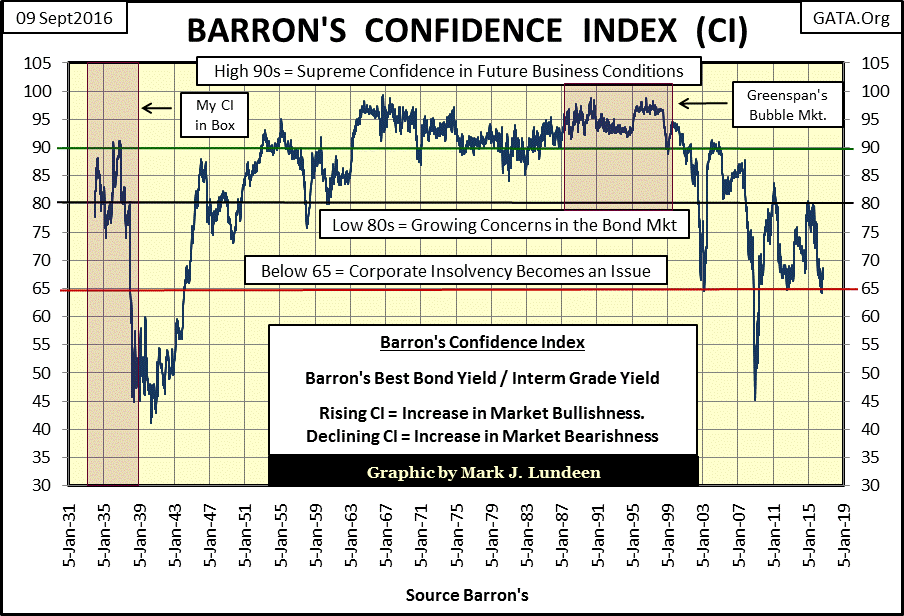Municipal Bond Yields And Barron’s Confidence Index
After two months the stock market finally saw a little excitement on Friday; the Dow Jones Index almost broke below 18,000 at the close. Two “policy makers” said FOMC “policy” isn’t market driven; that they may actually increase their Fed Funds Rate twice before the end of the year…come what may. As evident in the Dow Jones BEV chart below; that wasn’t what the bulls wanted to hear.
Well I’m all for that. These central-banking idiot savants have wasted eight years of people’s lives, when in December 2008 Doctor Bernanke began his QE to infinity and zero interest rate policies. This has only delayed the inevitable destruction of the banking system, a banking system that deserves to die by inflating their biggest bubble to date in the financial market.
I know that sounds horrible, but it’s true. I’m not the guy who allowed these financial institutions to practice fraud in mortgages and interest-rate derivatives, or looked away as they manipulated public financial markets for their personal gain. For their personal gain, Washington’s elected officials and market regulators did that.
The sooner the banksters get what they deserve, the better it will be for the rest of us, as horrible as that will be for all of us. So pull the plug, let Mr Bear finally take out the trash by marking-to-market all financial assets and bank reserves at the end of each trading day. If a few tens of trillion of dollars of an exotic derivative currently is being used as a bank’s reserves is found to have no buyers for the past year, so no market value can be assigned to it, shitcan the lot of it and send in the Department of Justice to investigate! Reinstituting integrity in financial accounting would go a long way in healing the wounds inflicted on the markets and economy by these people. That especially goes for the accounting of Washington’s income and outgo.
This will quickly deflate five decades of grotesquely inflated market valuations in stocks, bonds and real estate as fast as possible. Then we pick up the pieces, and get on with our lives as best we can. Maybe people’s kids who graduated from college in 2010 will then finally leave the basement and find a place of their own.
But if it makes you feel any better, there isn’t a chance in hell the FOMC will raise interest rates before the election. Hillary Clinton is the establishment’s choice for president. Starting a financial panic before the November election isn’t in her or their interest. So I can’t imagine The Queen Bee and her Honey Boys at the Fed raising interest rates until after the election. I’d like to see it happen, but don’t see how.
But why have these buffoons for years now keep coming out in public threatening to do so? There must be total chaos and frequent food fights at FOMC meetings. Violent recriminations of exactly who is the biggest idiot sitting around the table a daily occurrence. It’s just a fact of life; being a central banker today isn’t fun anymore, as it was in the 1990s. At the start of that decade, interest rates and bond yields were firmly over 7.5% and the “policy makers” hadn’t yet blown out their balance sheet with QE.
Look at the spread below between the Fed Funds Rate and the yield for the US Treasury’s long bond in Barron’s 01 Jan 1990 issue; it’s inverted a full 1.90% and all was well with the world. If in 2016 the “policy makers” raised their Fed Funds Rate to 1.90% (which wouldn’t invert the yield curve), they’d start a selling panic at the NYSE, and possibly cause a few hundred trillion dollars of interest-rate derivatives to come into the money, which would bankrupt the global banking system. This isn’t a monetary system, it’s a house of cards that one day will be scattered by the winds of change.
I can see the winds of change coming. Earnings for the Dow Jones have had an evolving relationship with Currency in Circulation (CinC) since 1929. In the insert of the chart below (1929-1979), there was about $1 of Dow Jones earnings (Blue Plot) for every $1 billion of CinC (Red Plot). Sometimes more, sometimes less, but undeniably for fifty years; earnings for the Dow Jones were inflated by monetary inflation flowing from the Federal Reserve.
Then came 1982; at the beginning of a stock-market bull the “policy makers” refuse to let die, the relationship between earnings for the Dow Jones and CinC changed. No longer did earnings for the Dow Jones float ever upward atop an ocean of rising “liquidity.” Beginning in 1982, earnings has behaved more like a dolphin; occasionally earnings would come to the surface for fresh air (Red Stars), before plunging back into the deep for years at a time.
Its first plunge (far left red star above) marked the start of the 1982-2000 bull market, seen in detail below. Note the 1982-2000 bull market (Blue Plot) began on collapsing earnings (Red Plot).
In the historical relationship between the Dow Jones Index with its earnings, this is not an anomaly. Here are two examples from the Great Depression era;
- The Great Depression Crash began on rising earnings. In July 1930 the Dow Jones found itself 40% below its September 1929 bull market top. However its earnings were up 41% during this same period of the great crash.
- The best year in the history of the Dow Jones (July 1932-33) saw the Dow advance 164% during this twelve month period. During this entire advance earnings were either collapsing or negative. The best year in the history of the Dow Jones was terminated when its earning finally became positive; July 1933.
This seems strange to today’s “market experts”, who now use trends in earnings to predict future price trends. But to market watchers of long ago, the decoupling of the price trend of the Dow Jones to its earnings was a frequent and unremarkable experience in the stock market. In fact, Charles Dow, the creator of the Dow Jones stock averages began the Dow Jones Average in the 1880s to predict the ups and downs in economic activity (aka earnings trends). Until Alan Greenspan became Fed Chairman in 1987, earnings frequently lagged the price trend for the Dow Jones, especially at critical market turns.
But all that changed, as seen in the three other red stars in the chart of Dow Jones Earnings and CinC (two charts up) when “policy” synchronized trends in the Dow Jones’ earnings to its valuation, as earnings bobbed up and down relative to growth in CinC:
- LBO / Junk-Bond Bear Market (1989-1992)
- High-Tech / Dot.Com Bear Market (2000-2002)
- Sub-Prime Mortgage Debacle (2007-2009)
Beginning in 1989, seeing earnings for the Dow Jones (Blue Plot) touch the red CinC plot marked a market top for the Dow Jones itself and the beginning of a series of progressively deeper bear markets.
In the post sub-prime mortgage bear market advance (our market advance), earnings for the Dow Jones once again rose up to, but failed to touch the CinC plot by a good amount. In fact, for the past two years earnings for the Dow Jones have been in decline as CinC, and the Dow Jones itself continues to advance.
I’m not concerned the CinC plot will reverse and come downward; since 1929 it never has before. Not with the FOMC there to ensure that from one year to the next, there will always be more paper and digital dollars “injected” into circulation. However, it appears the FOMC is having difficulty stuffing those dollars into the Dow’s earnings and ultimately into the Dow Jones itself.
Here’s the DJTMG’s 52Wk High and Low table. Nothing much has changed in the past few weeks, but I know some people like seeing the data. The coal mining shares must be anticipating a Trump victory, as Hillary has vowed to shut down every coal mine in the country if she becomes president.
Hillary says stuff like that to businesses and industries that don’t contribute to her favorite charity – the Clinton Foundation. If she becomes president, destroying the coal mining industry is one of the few promises she’s making we know she’ll keep. Yet the coal mining shares are at the top of the DJTMG list below, and have been since last spring. What do the buyers of coal mining stocks think they know that we don’t?
Maybe that after a major industry such as coal suffers a 98.30% collapse in valuation (BEV chart below) it was due for a good dead-cat bounce. The coal miners in September 2016 could be a buy of a lifetime. But I don’t see them that way. I still like the gold and silver miners; #3 in the table above.
One thought that comes to my mine when viewing the chart above is, if coal mining, a huge business that has been around since the 19th century, can collapse over 98% in such a short time, how many other groups in the DJTMG will suffer the same fate when Mr Bear goes back to work in earnest. Coal mining was taken down by the leftist-environmentalists in Obama’s EPA. But don’t think that debt laden high-tech and automobile manufacturers aren’t going to have their own big problems with debt service when the economy and markets begin to deflate!
Gold started the week on Tuesday with a bang, and ended it with a bust. However, looking at gold and its step sum in the chart below, really nothing much has changed, except market sentiment (the Red Step Sum Plot) is once again trending down. I call this the “battered bull syndrome.”
Even if gold breaks below $1300 I wouldn’t be concerned about the gold market. Actually should gold break below $1200 I still wouldn’t sell. The global financial system is in a mess. Gold and silver having no counter-party risks, makes them very attractive at this time, no matter what their price. Think in terms of ounces and pounds of gold and silver, not dollars.
If you’re like me, and fear a panic out of financial assets in a market crash, you must realize the proceeds from all those sell orders isn’t going into a banking system that is going down with the market. The likelihood of a panic into gold and silver as the next meltdown begins is substantially higher than house odds. But don’t think that retail investors will be able to buy the old monetary metals during a major melt up. So it’s best to buy before the crowd comes rushing in.
Gold closed the week at $1327.80 with its 15 count at -7. Look at it at the close of last week (September 2nd); its 15 count may be down 6 steps for the week, but the price was up $2.44. Nothing Earth shaking for the bulls happened this week. But for all the effort the bears made in the past week, they got nothing from their effort in the gold market. Look at all the down days since August 19th. In the past 15 trading days, only four saw the price of gold advance, yet the bears could only get gold down to $1327.80 from $1341.08? But they had a bit of success in silver.
Nothing changed in the past week for gold or silver. We’re still waiting for the week to arrive when the price of metal moves upward with authority taking their step sums with it. Sorry to say; I’m not the guy who can predict when that week will arrive.
Looking at gold with its open interest (OI) below, we see for the fourth time in 2016, the big banks are running up OI at the COMEX, promising to deliver tons of gold that doesn’t exist, gold they can’t get. What can I say? We have the best government Wall Street’s money can buy.
What can we do about it? Well, don’t vote for Hillary in November! I like Trump. At the thought of him becoming president, all the people I’ve been disparaging for the past eight years begin to foam at the mouth. So what’s not to like about “The Donald?”
You’ll never get anyone perfect for the job of being president. And the pain and suffering that is to come when Mr Bear goes to work is guaranteed in the next four years no matter who is president. The possibility of having someone in the oval office who will prosecute Wall Street’s elite, rather than bailing them out, plus having someone who will enforce the immigration laws that have been on the books for decades is good enough for me.
November of this year will be the sixth year where tax-free yields for municipal bonds have been higher than taxable yields for Barron’s Best Grade Bonds. In the chart below this inversion of yields has happened only twice before; at the end of the depressing 1930s, and during the Volcker Fed when short term rates were over 20%. But these yield inversions were smaller and short-term market anomalies. The current yield inversion has been continuous since November 2010; for the past 305 weeks.
For years (chart below) investors have chosen taxable bonds yielding at times almost a full percentage point less than investing in tax free municipal bonds. In April 2013 the inversion reached ninety-nine basis points, last week it was eighty-eight basis points.
On the face of it, this is a real anomaly. But then most people in the municipal bond market are wealthy individuals, who most likely are fully aware of the situation the Democratic Party, and government-employee unions have brought local government finances to. They simply are not going to buy muni bonds without receiving an appropriate default premium in the yield.
Gazing at my crystal ball, and yes the articles I’m reading on the budget busting pension liabilities for the States of Illinois, California, New York and etc. etc. etc., as well as cities in all fifty states, muni-bond purchasers will one day wish they got yields deep into the double digits, because most muni-bonds today are junk-bonds at great risk of default.
To be sure, there are municipal governments managed by responsible public officials who are not going to default on their debts. But looking at the charts above, it appears the rot in local-government finance runs deep. The bond market has been flashing a warning for the past six years.
It’s not just in the muni-bond market where yields are blowing out. Since the 2000-2002 high-tech bubble, intermediate grade bond yields have been widening from best grade bonds, as seen in Barron’s Confidence Index (CI) below.
There’s a lot of history in the CI chart below. Low CI numbers are associated with the bond market’s concerns of defaults, which were considerable in the late 1930s and during WW2. During the post war boom, concern of bond defaults gradually reduced to the point where in the early 1960s the CI increased to over 90, where it remained until the 1990s high tech bubble began to deflate. That’s almost four decades where the bond market had little to no concern for defaults in intermediate grade bonds, which are lower quality investment grade bonds.
All that changed after 2000; but why?
Decoupling the dollar from the Bretton Wood’s $35 gold peg took a few decades to fester before the bond market could no longer deny the malady in fixed income. It’s been well known for centuries; fixed income financial instruments don’t do well in an inflationary monetary regime.
After the 2000 top in the High-Tech Bubble, the spell cast on the bond market by Alan Greenspan (“the Maestro” as the Washington Post’s Bob Woodward called him in 2000) began to pass. Doctor Bernanke and the Queen Bee of “monetary policy” haven’t been able to restore the bond market’s confidence in their management of the dollar and the credit system. For good reason; that’s not going to change.
Mark J. Lundeen







